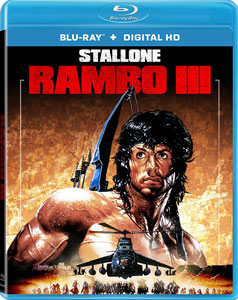Wading into the “Rambo” sequels, I braced myself for the point at which they’d get dumb. It doesn’t happen with the underrated “Rambo: First Blood — Part II” (1985), a top-shelf example of 1980s action with a tight plot that gives Rambo (Sylvester Stallone) a chance to “win” in Vietnam.
But it does unfortunately happen with “Rambo III” (1988). Granted, this is the best kind of dumb action movie, as some of cinema’s most quotable one-liners come from this flick.
Colonel Trautman (Richard Crenna) informs Russian Colonel Zaysen (Marc de Jonge) that the weapons shipment can be found “in his ass,” Rambo identifies himself to Zaysen as “your worst nightmare,” and Trautman distinguishes Rambo from God by noting that “God shows mercy.”

“Rambo III” (1988)
Director: Peter MacDonald
Writers: Sylvester Stallone, Sheldon Lettich
Stars: Sylvester Stallone, Richard Crenna, Marc de Jonge
Also providing humor is the degree of punishment Rambo takes. At one point, he cauterizes a wound in his side by filling it with gunpowder and lighting it on fire.
Tapping into current events
Written by Stallone and Sheldon Lettich (who penned many Jean-Claude Van Damme films) and directed by second-unit veteran Peter MacDonald, “Rambo III” notable for being a rare blockbuster action film that closely hews to current events of its time: the Soviet Union’s invasion of Afghanistan, which lasted throughout the 1980s.
And it doesn’t change Afghanistan to “Kamistan,” as “24” might do, or soft-peddle the fact that the Soviets are the villains.
Trautman is captured by the Soviets, and the idea is that the mujahideen will help Rambo rescue him on the condition that Trautman then gets the word out about the atrocities to the world at large – most of whom couldn’t locate Afghanistan on a map.
While “Rambo III” embraces these Muslim holy warriors as the good guys, as they fight against their Communist government backed by the Soviets, it doesn’t portray their culture very well. Some of the Afghan soldiers are played by Western actors (as are the Soviets, who are angry, shouting villains), and they aren’t distinguished from Westerners except by their garb and accents.
Morrell writes a richer story
“First Blood” author David Morrell does a better job of illustrating Afghan culture and nuances of the Soviet military in his brutally illustrative “Rambo III” novelization, which I recommend to both fans and not-quite-fans of this film.
For example, a kiss on the cheek is politeness in Afghan culture, whereas a handshake shows a permanent bond. The Afghans are split into many tribes, who have mutual respect but rarely team up. And they desire death in the holy war, as that is followed by paradise, as per their Muslim beliefs.
In the film, we see a handshake between Rambo and Masoud (Spyros Fokas), but we don’t get the extra meaning. Rambo gives young Hamid (Doudi Shoua) – who isn’t in the book — his Buddha charm, something the boy would not want, since he’s a Muslim.

There is a movie scene where the captive Trautman rips into Zaysen for the invasion, lecturing him about how the Americans learned their lesson in Vietnam, and now the Soviets are learning it in Afghanistan. They are trying to conquer an unconquerable people.
Morrell’s book gives us nuances beyond that, including the fact that Zaysen wants to be promoted out of this hellhole. Both versions feature a Russian defector, but the film lacks the book’s drama over whether Rambo can trust this man or not.
Rambo becomes a superhuman
In the film, there’s not much believable military strategy; it’s more a case of Rambo being superhuman. He and his guide/friend, Mousa (Sasson Gabai), kill dozens of soldiers and blow up several buildings in the Soviet fort, and Rambo later free-climbs a cliff side. Then he does it all a second time. Much of our hero’s success depends on the Russians being worse marksmen than the stormtroopers in “Star Wars.”
Both versions show the chaos of Afghanistan – “the land of the out of control,” as Morrell says – but in the book it’s a detailed description of chaos and in the film it’s the chaos of plot convenience overcoming real-world logic.
The production design is outstanding; clearly a lot of work and money went into building the fort. Locations in Israel and Arizona effectively stand in for Afghanistan, replete with the famous caves where we hear about terrorists hiding today.
The Russians’ bombing raids with their helicopter gunships (also seen in the second film) have echoes of today’s American drone bombers, which have taught Middle Easterners to fear the sky.
When a closing title card says this film is dedicated to the brave people of Afghanistan, it might induce unintentional laughs because we’ve just watched 100 minutes of one-liners, sometimes inexplicable explosions, sketchy military strategies, unclear geography and Rambo’s almost magical ability to get out of dire situations. An entire parody, 1993’s “Hot Shots! Part Deux,” is inspired by this film.
But I can’t grade it too harshly. “Rambo III’s” heart is in the right place, as it aims to show the underdogs’ plight in a movie that will reach a bigger audience than a newspaper blurb. And while it may be the dumb kind of blockbuster fun, it’s still fun.

